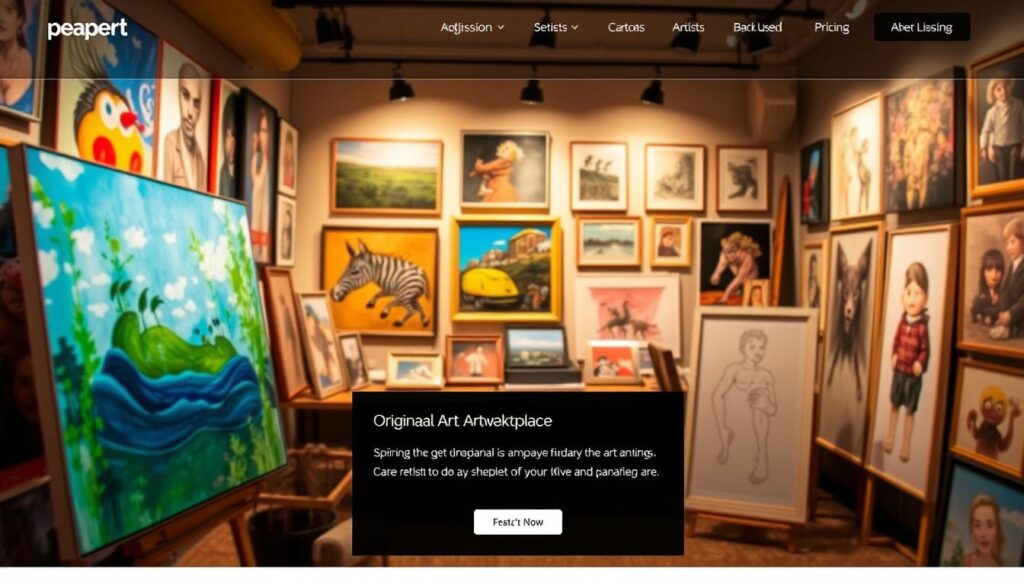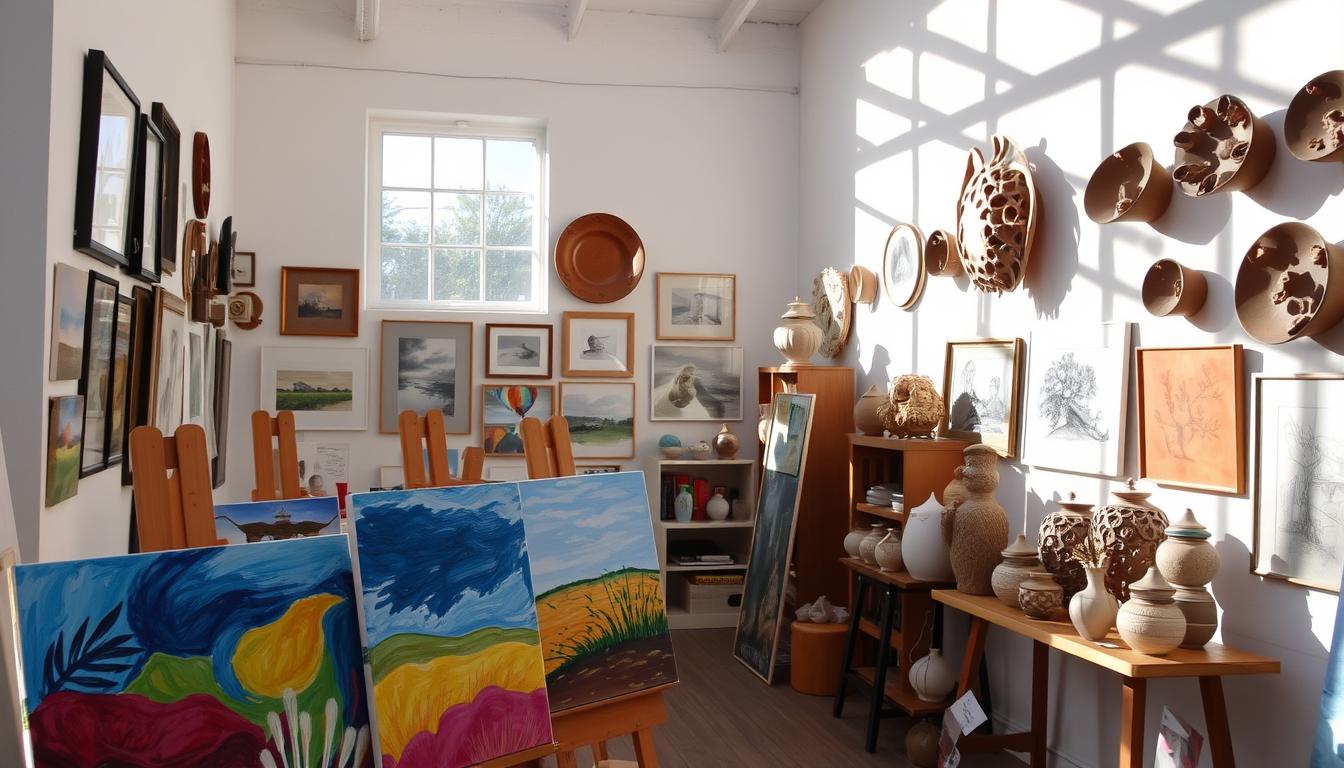Artists seeking to monetize their unique art pieces often find themselves navigating a complex and competitive market. Understanding the intricacies of the art world is crucial for success.
To effectively capitalize on their creations, artists must be well-versed in preparing their work for the market. This involves not only showcasing their talent but also understanding the needs and preferences of potential buyers.
By grasping the fundamentals of the art market and adopting a strategic approach, artists can increase their visibility and attract buyers interested in authentic artwork.
Key Takeaways
- Understand the art market dynamics to successfully sell your art.
- Prepare your artwork effectively to appeal to potential buyers.
- Develop a strategic approach to increase your visibility in the art world.
- Identify and cater to the needs and preferences of your target audience.
- Showcase your talent and uniqueness to stand out in the competitive art market.
Understanding the Art Market
Understanding the dynamics of the art market is crucial for artists looking to sell their work. The art market encompasses various segments, including online platforms and physical galleries, where artists can buy original art online or directly from studios.
Different Types of Art Buyers
Art buyers range from individual collectors to corporate entities. They may be motivated by aesthetic appeal, investment potential, or emotional connection. Knowing these motivations can help artists tailor their marketing strategies.
Current Trends in Art Purchasing
Current trends show a shift towards online platforms for art purchasing, with many buyers seeking original paintings for purchase or exclusive art for sale online. This shift has opened new avenues for artists to reach a broader audience.
| Type of Buyer | Motivation | Preferred Art Type |
|---|---|---|
| Individual Collector | Aesthetic, Emotional | Original Paintings |
| Corporate Entity | Investment, Decoration | Exclusive Art Pieces |
Identifying Your Target Audience
Identifying the target audience is key to successful art sales. Artists should research their potential buyers’ preferences and tailor their work and marketing strategies accordingly.

Preparing Your Original Artwork for Sale
The presentation of your original artwork plays a vital role in capturing the attention of potential buyers. Whether you’re selling genuine art pieces for sale or one-of-a-kind artwork for sale, the initial impression is crucial.
Professional Photography of Your Art
High-quality photography is essential for showcasing your artwork. It allows potential buyers to appreciate the details and nuances of your original art prints for sale. Consider hiring a professional photographer who specializes in art photography to capture your work in the best light.
Creating Compelling Artwork Descriptions
Compelling descriptions can significantly enhance the appeal of your artwork. Include details about the inspiration behind the piece, the materials used, and the creative process. This narrative can help potential buyers connect emotionally with your one-of-a-kind artwork for sale.
Proper Documentation and Authenticity
Ensuring the authenticity and proper documentation of your artwork is critical. Provide certificates of authenticity and any relevant provenance to establish the value and legitimacy of your genuine art pieces for sale. This step is vital in building trust with potential buyers.
Pricing Strategies That Attract Buyers
To successfully sell original artwork, understanding and implementing effective pricing strategies is essential. Pricing your artwork correctly can make a significant difference in attracting potential buyers and standing out in a competitive market.
Factors That Determine Art Value
The value of your artwork is determined by several factors, including your reputation as an artist, the medium used, the size of the piece, and its complexity. Establishing a pricing structure based on these factors helps in creating a fair and competitive price. For instance, larger and more complex pieces typically command higher prices due to the increased time and skill required to create them.
Pricing Methods for Emerging Artists
Emerging artists often face challenges in pricing their work. A common strategy is to start with lower prices to attract early buyers and build a portfolio. Calculating costs, including materials and time, provides a baseline for pricing. Researching what similar emerging artists are charging can also help in setting competitive prices.
“Pricing is not just about covering costs; it’s about the perceived value of your artwork.”
When and How to Offer Discounts
Offering discounts can be an effective way to attract buyers, especially during the initial stages of your career or when selling from a new collection. Limiting discounts to specific periods or collections can create a sense of urgency among potential buyers. It’s also crucial to communicate the value of your artwork and the reasoning behind your pricing to justify the original price.
By understanding the factors that determine art value, adopting appropriate pricing methods, and strategically offering discounts, you can price your original artwork for sale in a way that attracts buyers and supports your career as an artist.
Best Platforms for Original Artwork for Sale
In today’s digital age, artists have numerous opportunities to sell their original artwork through various online and offline channels. Understanding these platforms is crucial for artists to reach their target audience effectively.
Online Marketplaces and Galleries
Online platforms have revolutionized the way art is bought and sold. They offer a global reach, making it possible for artists to connect with buyers worldwide.
Etsy, Saatchi Art, and Artfinder
Popular online marketplaces like Etsy, Saatchi Art, and Artfinder cater to a wide range of art buyers. These platforms are known for showcasing diverse art styles and providing tools for artists to promote their work.
- Etsy: Known for handmade and vintage items, including art.
- Saatchi Art: A platform that features emerging artists and offers a curated selection of original art.
- Artfinder: Allows artists to sell their work directly to buyers, with a focus on original art.
Creating Your Own Artist Website
Having a personal website gives artists control over their brand and sales. It’s an opportunity to showcase their portfolio, share their story, and connect directly with potential buyers.
Key features of an artist’s website should include:
| Feature | Description | Benefit |
|---|---|---|
| Portfolio Gallery | A showcase of the artist’s work | Visual representation of the artist’s style and talent |
| Artist Statement | A description of the artist’s inspiration and philosophy | Helps buyers understand the context and meaning behind the art |
| Contact Information | Easy way for buyers to get in touch | Facilitates communication and potential sales |
Physical Venues and Opportunities
While online platforms are powerful, physical venues remain essential for showcasing and selling original art.
Local Galleries and Art Fairs
Local galleries and art fairs provide opportunities for artists to gain exposure and sell their work. These venues attract art enthusiasts and collectors looking for unique pieces.
Pop-up Exhibitions and Open Studios
Pop-up exhibitions and open studios are innovative ways for artists to connect with their audience. They offer a more personal and immersive experience, allowing potential buyers to engage with the art and the artist.
By leveraging both online and offline platforms, artists can maximize their reach and increase their chances of selling their original artwork.
Marketing Strategies to Reach Art Collectors
To successfully sell original paintings for purchase, artists must employ targeted marketing strategies. Effective marketing helps increase visibility, attract potential buyers, and ultimately drive sales.
Building Your Distinctive Artist Brand
Establishing a unique artist brand is crucial for standing out in the competitive art market. This involves creating a consistent visual identity, developing a compelling artist statement, and showcasing a cohesive body of work that reflects your artistic vision.
Leveraging Social Media for Art Sales
Social media platforms offer a powerful tool for artists to showcase their work and connect with potential collectors. By regularly posting high-quality images of their artwork, engaging with their audience, and utilizing relevant hashtags, artists can increase their online presence and attract buyers interested in one-of-a-kind artwork for sale.
Email Marketing and Newsletters
Building an email list and sending out regular newsletters is an effective way to keep collectors informed about new artwork, upcoming exhibitions, and special promotions. Newsletters can help artists maintain a direct connection with their audience and encourage repeat business and referrals.
Networking in the Art Community
Networking within the art community is vital for artists looking to expand their reach and attract new collectors. This can involve participating in art fairs, collaborating with other artists, and engaging with galleries and art consultants who can help promote their original art prints for sale.
By implementing these marketing strategies, artists can effectively reach and engage with potential collectors, increasing their chances of selling their artwork.
Converting Interest into Sales
Converting interest into sales is a crucial step for artists looking to succeed in the competitive art market. This process involves several key elements, including effective communication, smooth transaction handling, and careful shipping and delivery practices.
Effective Communication with Potential Buyers
Responding promptly to inquiries about authentic artwork for sale is vital. Artists should be prepared to answer questions about their work, provide additional photos or information as requested, and engage in discussions about the artwork’s value and significance.
Building a rapport with potential buyers can help establish trust and increase the likelihood of a sale. This can be achieved through personalized communication and a clear understanding of the buyer’s needs and preferences.
Handling Payments and Transactions
Artists should have a secure and reliable system in place for handling payments and transactions. This may involve using reputable online payment platforms or working with a financial institution to process transactions.
| Payment Method | Security Features | Transaction Fees |
|---|---|---|
| Credit Card | Encryption, Two-Factor Authentication | 2.5% |
| Bank Transfer | Secure Sockets Layer (SSL) | 1% |
| Online Payment Platforms | Fraud Detection, Buyer Protection | 3% |
Shipping and Delivery Best Practices
Once a sale is made, artists must ensure that the exclusive art for sale is shipped safely and efficiently. This involves using sturdy packaging materials, tracking shipments, and providing buyers with updates on the delivery status.
By following these best practices, artists can build a positive reputation and encourage repeat business, ultimately driving sales of their genuine art pieces for sale.
Conclusion
Successfully selling original artwork requires a combination of understanding the art market, preparing your work for sale, and effectively marketing your unique art pieces for sale. By identifying your target audience and leveraging the right platforms, you can increase your visibility and attract potential buyers.
Artists who adopt a strategic approach to pricing, branding, and networking are more likely to convert interest into sales. Whether through online marketplaces or physical venues, showcasing your original artwork for sale to the right audience is crucial.
By applying the insights and strategies outlined in this guide, artists can enhance their career prospects and achieve success in the competitive art market. Focusing on building a distinctive brand and engaging with art collectors can lead to a loyal customer base and sustained sales of unique art pieces for sale.
